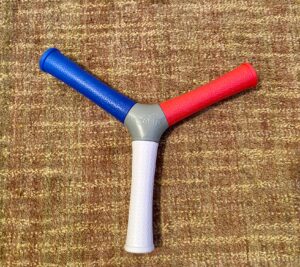Brian Schiff’s Blog
Injury Prevention, Sports Rehab & Performance Training Expert
Over the years, I have tested many different fitness products through my work with Personal Fitness Professional Magazine. I am not paid to promote any products on my site, and this latest review comes after spending the past few weeks using this particular product in the clinic with my patients. I am pleased to bring attention to it because I think it can help with recovery and training.
Recently, the inventor of the HECOstix, Josh Broeker, reached out to me to see if I have had a chance to use his product. Much to my surprise, I was not familiar with it. As a performance physical therapist working with many athletes from various sports and ranging from youth to professionals, I was naturally excited to see the product in action. I am always looking for ways to enhance neurocognitive training and my rehab. Josh was gracious enough to send me a few HECOstix to try out.
For those unfamiliar with the product, see the image of the Red, White and Blue version below:

As I rehab and progress athletes back to sport after injury, implementing tools to improve hand eye coordination, reaction time, cognitive skills and decision making is important prior to sending them back to practice and sport. A few of the really cool features I like about this product include:
- Lightweight and durable EVA make-up
- Different versions and multiple colors allow for auditory cues and quick reaction
- It can be used safely by all ages and abilities
- Travels easily with you anywhere
The HECOstix can be used for virtually any sport and done indoors or outdoors. Perhaps the greatest thing about the product is that it injects FUN into training while allowing users to compete against others or their own results in an effort to improve performance. This tool also allows for progressive challenges moving from underhand to sideways to overhead throws depending on the functional demands and skill level of the participants.
In the clinic, I have been using it with some of my patients rehabbing after ACL reconstruction. Adding neurocognitive training is essential for full recovery and secondary prevention. below is an article from Sports health discussing neurocognitive and neurophysiological functions related to ACL injury:
https://pubmed.ncbi.nlm.nih.gov/34236003/
Specifically, I have integrated it with dynamic balance and movement drills calling out a color while throwing the HECOstix toward the client. I have also had a pair of patients throwing and calling out the color as part of a rehab game. I will be continuing to use it with this population and other athletes working on hand eye coordination and cognitive training for their sport.
If you are looking to add a new wrinkle to your training or rehab, I highly recommend giving this product a try. For more information on the product, be sure to visit www.hecostix.com.
Unfortunately, injuries cause more than pain and lost playing time for athletes. In many cases, an injury negatively impacts self-esteem and creates fear and anxiety. For competitive athletes, the injury often separates them from their familiar role and identity with respect to their teammates, coaches and peers.
It seems rather obvious that injured athletes would want to return to sport as soon as possible, right? Based on my clinical observations and experience, most athletes are motivated to return after their first injury. The more serious the injury (e.g. ACL tear, Achilles tendon rupture or UCL tear), the longer the road to get back. The speed and ease of the process is affected by the patient’s response to injury and surgery (coper vs. non-coper), degree of injury, skill of the surgeon, effectiveness of rehab, and patient compliance.
Much of the research done to date with fear of re-injury has centered on athletes undergoing ACL reconstruction. Over the last decade, methods for measuring kinesiophobia (fear of movement associated with sport/injury) such as the Tampa Scale of Kinesiophobia. I routinely use the TSK-11 with my athletes. In addition, the ACL-RSI is another tool for evaluating psychosocial readiness to return to sport. As sports medicine practitioners, we must pay attention to our clients’ fears and mental status.
Invariably, not all athletes want to return to sport. Factors that may hinder return to sport are:
- Chronic pain
- Fear of re-injury
- Fear or anxiety about long term pain, injury or future disability (such as osteoarthritis)
- Anxiety about not being able to return to their prior level of performance
As we age, balance steadily declines. This exercise is an effective and fun way to challenge balance and increase lower body strength. I typically incorporate it for clients dealing with patellofemoral knee pain, glute and hip dysfunction as well as anyone struggling with dynamic limb stability. Watch the video below and give it a try yourself!
The idea behind this exercise is applying progressive gradients of resistance that encourage the faulty motion (pulling the leg into adduction and internal rotation) to facilitate increased activation of the gluteus medius/minimus and small lateral rotators to create an anti-adduction/internal rotation force by forcing the brain to work against the unwanted motion (better central nervous system activation). Decreasing such moments at the knee will reduce IT Band issues, patellofemoral pain, ACL injury risk and overuse problems often seen in running.
The video below from my online column for PFP magazine demonstrates how to execute this exercise. It is a great corrective and prehab training activity.
I am currently working to attain my transitional doctorate in physical therapy (tDPT) at Northeastern University. As I continue to work full time as a clinician, it has been really cool to apply the learning with my current caseload. At this time, I am in a motor control class that is both fascinating and challenging. In week three, we examined pain and the impact it has on neuroplasticity (the brain’s ability to adapt or change).

In the sports medicine realm, I generally think many practitioners solely focus on the musculoskeletal system or physical impairment. As such, interventions are developed around tissue constraints, ROM deficits, weakness, etc. Too often, we look past the power and impact of the brain and how it plays a vital role in healing and return to play. For some patients, there is a maladaptive response to injury/surgery and a hypersensitivity of the central nervous system or central sensitization that occurs. Pelletier (2015) notes that structural and functional changes can occur. (1)
Two critical concepts to consider here are:
- Sensory amplification – sensory and motor representations change resulting in perceptual changes in body image, motor control changes, and even a persistence or amplification of pain
- Experience dependent plasticity – patient’s response to pain is related to prior experience and may experience maladatpive imprinting where the pain outlasts the physical insult
Kleim (2008) gives a great lesson on experience dependent plasticity and states that learning is essential for the brain to adapt to damage self taught behavioral changes can be maladaptive or positive and specific forms of neural plasticity and associated behavioral changes are dependent on specific kinds of experience (2). While one would assume that chronic pain is rare in athletes, I would counter and say it is probably just overlooked as we tend to expect athletes to “push through the pain” because of the driven culture we live in. Coaches, parents and even teammates can affect the mindset around injury and recovery.

